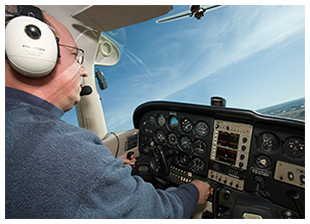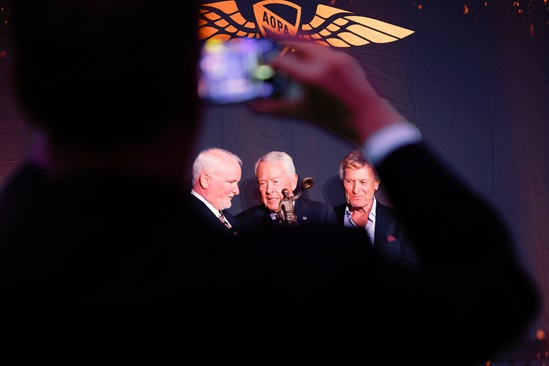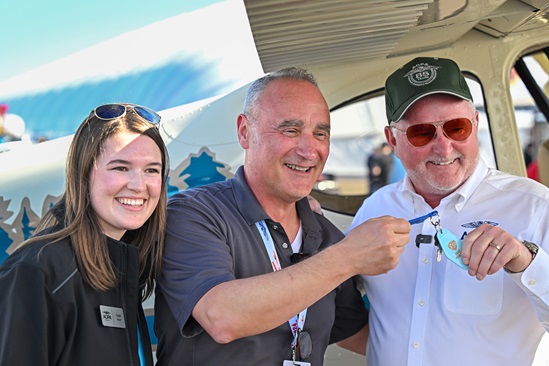Training Tips |
What's the call?
A business jet departs, and another is cleared for takeoff. Then an aircraft with the word "heavy" in its call sign checks in from several miles out on final. The tower informs the heavy that it is number two to land, following "a Cessna single that is about to turn base." (Surprise: That's you.) Next, the tower calls your number and instructs, "Make a short approach, cleared for the option." If you fly regularly from a tower-controlled airport, especially during busy periods, scenarios like this will soon become familiar. One lesson they teach is to develop the good habit of monitoring all the frequency's radio traffic so you know the position of other arriving and departing aircraft. Another is that no two circuits of a busy pattern will be alike. In past practice sessions, you may have had to respond to requests to "expedite" a takeoff, or to exit a runway with no delay. On a touch and go, a controller may have instructed you to take minimum time on the runway, or to begin your crosswind turn earlier than usual. On a few occasions you may even have been vectored out of the pattern briefly to accommodate traffic. Now, if separation from the heavy aircraft following you gets too tight, the controller could amend your clearance to "touch and go only." If you start to feel a bit squeezed or pressured, volunteering to go around also would help (and the offer might be gratefully accepted). In the meantime you remain cleared for the option, which, according to the Pilot/Controller Glossary, is an ATC authorization "for an aircraft to make a touch-and-go, low approach, missed approach, stop and go, or full stop landing at the discretion of the pilot." You wanted to make a stop and go to maximize your landing practice in that crosswind—but given your traffic, perhaps that's not the best choice. It's decision time. What's your call? Training ProductsKing Schools offers sport pilot knowledge courseKing Schools is now offering the Sport Pilot Airplane Exam Course on DVD for the PC. The computer-based interactive video covers the subject matter in an interesting and entertaining way, using bold, full-screen graphics coupled with interactive questions to reinforce learning and keep motivation high. The cost is $279. ASA offers communications trainingASA has added Communications Trainer: Say Again, Please, to its line of interactive computer-based tutorial products. Pilots will increase their comfort level when using an aircraft radio with examples of typical transmissions that explain how the air traffic control system works, presenting simulated flights that clearly demonstrate correct communication procedures. The cost is $49.95. Note: Products listed have not been evaluated by ePilot editors unless otherwise noted. AOPA assumes no responsibility for products or services listed or for claims or actions by manufacturers or vendors. Final ExamQuestionYou establish two-way radio communications with the tower of the primary airport prior to entering the Class D airspace. The tower request: that you make a straight-in approach to Runway 27. You acknowledge that you will comply with that request. As you continue the approach you hear nothing from the tower. You call the tower seeking a clearance to land. Again, nothing heard from the tower. It is VFR and you can see the tower. How should you proceed? AnswerA communications failure has occurred after you have entered the Class D airspace. FAR § 91.129(d)(2) provides guidance in this situation. It explains that if the radio fails in flight under VFR the pilot in command may operate and land if— "i. Weather conditions are at or above basic VFR weather minimums; A clearance to land in this situation would be a steady green light from the tower. See FAR § 91.125, ATC light signals. Got a question for our technical services staff? Contact AOPA. |
 It's your third trip around the traffic pattern at the tower-controlled airport. You are established downwind, ready to run your pre-landing checks. On your two first circuits you did a nice job—especially handling a slight crosswind component—but on this next landing you think you can do even better. That's what practice is all about, and it pleases you to realize that your skill has advanced to the point where you can focus on finesse.
It's your third trip around the traffic pattern at the tower-controlled airport. You are established downwind, ready to run your pre-landing checks. On your two first circuits you did a nice job—especially handling a slight crosswind component—but on this next landing you think you can do even better. That's what practice is all about, and it pleases you to realize that your skill has advanced to the point where you can focus on finesse.

